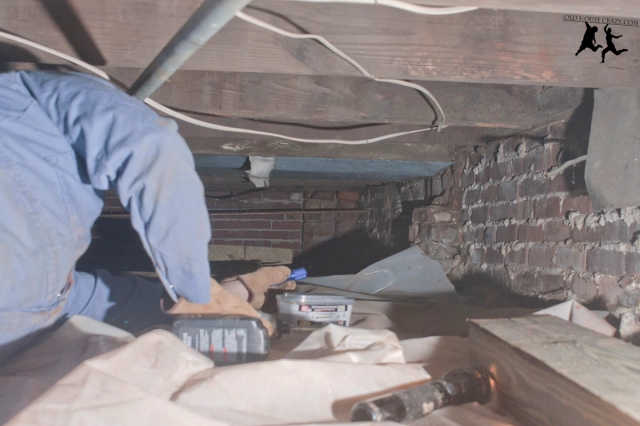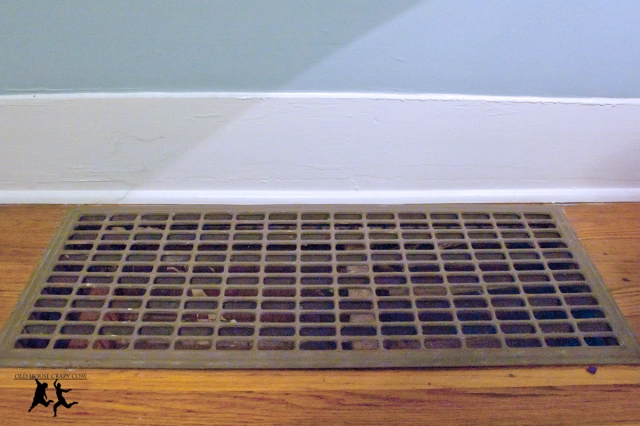Why Isnt This Old House on Again
Toll, Time, and Skills:
This job took two people 1 afternoon. We got dingy because nosotros were in a dirt crawlspace doing just that, crawling. Nosotros used 18,000-pound screw jacks, iv×4 lumber, a circular saw, power drill/driver, and cement blocks. Total cost was less than $200, while a pro would charge $500-$m.
The Story:
This by Saturday, my brother had me over to help move some of his article of furniture during the annual rearranging of the boob tube room. The photo below shows what nosotros saw when we moved the burrow away from the wall.

Look for the one inch gap between the floor and the base board
Apparently, information technology's been that style since they bought their 90-year-old bungalow and it's been nagging at my brother ever since. You lot may accept similar areas in your home. You probably experience the same way my brother did: "information technology's not THAT large a deal and it'll cost at least $chiliad to repair, and then let'due south purchase diapers and food and gas with our money instead." Well, information technology isn't THAT big a bargain at present, but it could develop into a whole host of problems downwards the line, especially if the sagging is caused past a larger issue.

Three 18000 lb screw jacks and solid concrete blocks for back up
The truth is, it will cost y'all up of a thousand dollars to rent professionals to do anything to your foundation or the nether-construction of your habitation. Merely plan on that. Plus, it's hard to detect the right people to practise this work, because it requires on-site problem solving and a certain amount of risk assessment (don't rent anyone that seems kind of stupid). I know this. We paid to have some piece of work washed on our sill plate last summer and it hurt the wallet. A lot. However, watching the crew work on my house permit me know that I could certainly do that piece of work myself the adjacent time the need arose.

We ripped the two×ten's in half to brand four four ft joists
As a homeowner with an eye for and involvement in how things work, I've learned an extremely important thing: my business firm is really really only congenital and nothing in here is all that complex. The trouble is knowing what to practise and what tools to buy. If yous aren't good at figuring stuff out on your own, rent someone. . . once. While they're working, ask them questions most the procedure and about what they're doing. Assess whether you think you tin do it yourself. I learned most of my skills out of necessity (it's a cash flow thing) and by watching professionals.

As with many old houses, my brother's has a tiny crawl infinite door. I'm large and so that makes me unhappy.
For this chore, every bit with any job, nosotros outset needed to figure out what the root problem was. The sagging flooring was the symptom, and somewhere under the house there had to be a cause. Well, after doing the navy SEAL crawl upward under the house, we found that the joists that were supporting that flooring were not actually fastened to the sill plate whatever longer, as seen in the photo below. This is an obvious trouble, because the fact that the sill plate is the first line of support above the foundation wall. You tin can encounter that the joist had dropped virtually an inch below the sill, explaining the inch the floors had sunk.

The joist had slipped near an inch from the sill
In club to lift this section of floor support an inch, we needed to purchase a few screw jacks, which can be purchased at your local large box hardware store for well-nigh $xxx per jack. The ones in the photos above are really not the ones we ended upwardly using. We had to purchase shorter ones. Merely hey, what's a home comeback project without at least two trips to the store?

Moving effectually under old houses tin can be tricky. My blood brother'south crawlspace opens up quite a bit in one case yous're inside. It used to be a dry cellar for storing produce during the summertime, with a trap door in the kitchen.
Every bit you can run into in that last photo, my brother's crawl space is rather spacious in spots. Unluckily for us, the spot we were working wasn't one of the spacious ones. Here he is squeezing through the little trap door. Notation the coveralls. I'd recommend covering yourself when working under the house. It's nasty and there are spiders and junk.

A gift my brother and I both possess: flashing a goofy smile at a moment's observe.
Here's where we were working. The two″x8″ joists you lot encounter in the photograph (the boards running from left to right higher up my brother for the lay men) are the ones nosotros would exist supporting. We decided that we wanted to sister a new 2″x10″ lath up against the existing joists and back up the new joists. We chose this method because of the small corporeality of old termite damage we saw in some of the old joists. What we did was lay the new board flush with the floor boards and with the old joist. We and then fastened the 2 boards together with 3 inch forest screws.

The crawlspace was really tight in the area nosotros were working. Luckily, it was pretty dry. The vapor barrier and exterior drainage had done their job well.
Below, you can see my brother prepping one of the new joists by partially driving the screws into the woods. This is surprisingly difficult to do when property a twenty pound joist and a drill to a higher place your head while lying on your back.

I used to balk at the drills and power tools that come with a light. Non any more. That little light came in very handy.
With the mud and the muck, I didn't get whatsoever photos of the adjacent step or two. In the photo beneath, you see the terminal product. Yous can see how the new joists are attached and, if you look towards the background, how they overhang the old joists and then the support beam is only pushing on the new joists.

Here's the completed job. The new joists are attached to the old joists and are supported by the four×4's and screw jacks.
In one case the new joists were up, nosotros constitute locations where the physical blocks could sit down flat on the basis so the pressure wouldn't cause them to crack. Later on they were in place, we hoisted up the 4″x6″x8′ beam so that it crossed all four of the new joists, sliding the spiral jacks underneath. With the axle resting nicely on the jacks, we slowly turned the cherry handles until the beam was in contact with two of the joists. And then we kept turning until it was in contact with all 4 of the joists (the lower ii lifted up to be in line with the higher two). By yelling through the flooring to my brother's wife, nosotros were able to coordinate our slow turning of the spiral jacks until the cleft between the floor and the base of operations lath was gone.

Here's the last product. Total, this job price my brother $150-$200, where a pro would easily have charged $800-$1000. I'll admit, this is probably not the job for a first time do-information technology-yourselfer, but folks with a little experience and confidence can easily repair the sagging floors in their homes.

Look for the 1-inch gap betwixt the floor and baseboard. It's not in that location any more.
The before and subsequently is below. If you lot've got questions or comments, go out them below or contact u.s.a. at oldhousecrazy@gmail.com. Also, experience free to leave us a comment on our facebook page www.facebook.com/oldhousecrazy. Cheers for reading. -Robby

Before and After
Source: https://oldhousecrazy.com/2012/01/23/lifting-up-a-sagging-floor-diy/
0 Response to "Why Isnt This Old House on Again"
Post a Comment